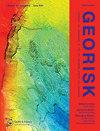外淹概率安全评价方法在原型快中子增殖反应堆中的应用
IF 4.8
3区 工程技术
Q1 ENGINEERING, GEOLOGICAL
Georisk-Assessment and Management of Risk for Engineered Systems and Geohazards
Pub Date : 2022-10-02
DOI:10.1080/17499518.2022.2144636
引用次数: 0
摘要
本文介绍了原型快中子增殖反应堆外淹概率安全分析所采用的方法、事故序列分析和显著结果。主要步骤是概率危害估计、脆弱性计算、系统可靠性建模和风险量化。对通常与沿海地点有关的降雨、风暴潮和海啸进行了危害分析,从中估计了洪水水位与年超过频率的相关函数。利用阶跃易损性函数,考虑了不同安全系统的沉没破坏模式,对不同安全系统进行了易损性分析。洪水的次生效应,如碎片冲击、负荷下降和洪水引起的钠火灾等没有考虑。对控制室和现场操作进行了工厂安全所需的人工操作的人为可靠性分析。在分析过程中遇到的挑战,突出的结果和不确定性所涉及的推论提出。缩写:AHX:空气换热器;CDF:堆芯损坏频率;EFPSA:外部洪水概率安全评估;EL:海拔高度;EOP:紧急操作程序;ET:事件树;FT:故障树;HRA:人的可靠性分析;IE:发起事件;NPP:核电站;OGDHRS:运行级衰变排热系统;原型快中子增殖反应堆;POT:峰值超过阈值;PSA:概率安全评估;概率海啸灾害评估;RY:反应堆年;RCB:反应堆安全壳;RP:退货期;SGDHRS:安全级衰变排热系统;SSC:结构、系统和组件本文章由计算机程序翻译,如有差异,请以英文原文为准。
Application of external flood probabilistic safety assessment methodology to Prototype Fast Breeder Reactor
ABSTRACT This paper presents the methodology adopted, accident sequence analysis and salient results from the external flood probabilistic safety analysis exercise for Prototype Fast Breeder Reactor. The major steps performed are the probabilistic hazard estimation, fragility computation, system reliability modelling and risk quantification. The hazard analysis has been performed for rainfall, storm surge and tsunami as typically associated with a coastal site, from which correlation function relating flood level to the annual exceedance frequency is estimated. The fragility analysis of different safety systems is estimated by considering submergence mode of failure using step fragility functions. The secondary effects of flood such as debris impact, load falling and flood-induced sodium fires are not considered. The human reliability analysis of manual operations necessary for plant safety is done for the control room as well as onsite actions. The challenges encountered during the analysis, salient results and uncertainties involved are presented with inferences. Abbreviations: AHX: air heat exchanger; CDF: core damage frequency; EFPSA: external flood probabilistic safety assessment; EL: elevation levels; EOP: emergency operation procedure; ET: event tree; FT: fault tree; HRA: human reliability analysis; IE: initiating events; NPP: nuclear power plant; OGDHRS: operation grade decay heat removal system; PFBR: prototype fast breeder reactor; POT: peak over threshold; PSA: probabilistic safety assessment; PTHA: probabilistic tsunami hazard assessment; RY: reactor year; RCB: reactor containment building; RP: return period; SGDHRS: safety grade decay heat removal system; SSC: structures, systems and components
求助全文
通过发布文献求助,成功后即可免费获取论文全文。
去求助
来源期刊
CiteScore
8.70
自引率
10.40%
发文量
31
期刊介绍:
Georisk covers many diversified but interlinked areas of active research and practice, such as geohazards (earthquakes, landslides, avalanches, rockfalls, tsunamis, etc.), safety of engineered systems (dams, buildings, offshore structures, lifelines, etc.), environmental risk, seismic risk, reliability-based design and code calibration, geostatistics, decision analyses, structural reliability, maintenance and life cycle performance, risk and vulnerability, hazard mapping, loss assessment (economic, social, environmental, etc.), GIS databases, remote sensing, and many other related disciplines. The underlying theme is that uncertainties associated with geomaterials (soils, rocks), geologic processes, and possible subsequent treatments, are usually large and complex and these uncertainties play an indispensable role in the risk assessment and management of engineered and natural systems. Significant theoretical and practical challenges remain on quantifying these uncertainties and developing defensible risk management methodologies that are acceptable to decision makers and stakeholders. Many opportunities to leverage on the rapid advancement in Bayesian analysis, machine learning, artificial intelligence, and other data-driven methods also exist, which can greatly enhance our decision-making abilities. The basic goal of this international peer-reviewed journal is to provide a multi-disciplinary scientific forum for cross fertilization of ideas between interested parties working on various aspects of georisk to advance the state-of-the-art and the state-of-the-practice.

 求助内容:
求助内容: 应助结果提醒方式:
应助结果提醒方式:


